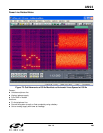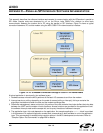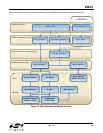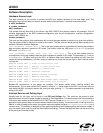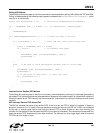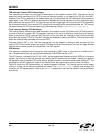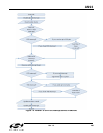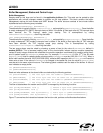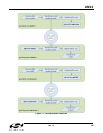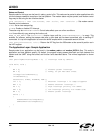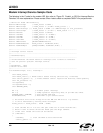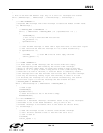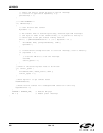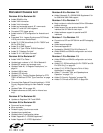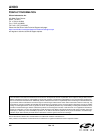
AN93
298 Rev. 1.3
Status and Control
Sample code for this layer can be found in status_control.c file. This code can be ported to other applications with
minimal changes needed to compile on the host platform. The modem status may be queried, and modem control
flags may be set using the two functions below:
void setControl( char controlCode, char action, char condition ): Set modem control.
Possible control codes are:
SiESC: Set or clear escape flag.
SiINTM: Enable or disable U70 interrupt.
The action may be
ENABLE or DISABLE. Control takes effect upon one of two conditions:
NOW: Unconditionally upon entering the function call.
WHEN_TX_BUF_EMPTY: The setControl() function loops until the gUARTToModemBuffer[] is empty. This
enables, for instance, setting the escape code after a given data set has been transmitted, prior to sending AT
commands. It is up to the application to ensure the buffer empties within a reasonable amount of time.
char queryU70IntStatus( void ): Returns the INT flag from the ISOmodem at the same bit position as in
the HIR1 register.
The Application Layer: Sample Application
Sample code for an application can be found in the modem_main.c and modem_80C51.h files. This code is
application and host platform specific. By default, the program simply passes data back and forth between the
modem and the UART using the buffers and function calls described above. The minimal application is shown
below:
char gPollingNotInterruptMode = 0; // Interrupt mode by default
void main( void )
{
EA = 0; // Disable global interrupt
EA = 0; // Dummy, as per MCU data sheet
initApplicationBuffers();
initHardware();
setControl( SiESC, DISABLE, NOW );
IT1 = 1; // External interrupt 1 is edge triggered
EX1 = 1; // Enable external interrupt 1
PS = 1; // High interrupt priority for UART0
PX1 = 0; // Low interrupt priority for modem side
EA = 1; // Enable global interrupt
while ( 1 )
{
modemCommunicationUpdate();
UARTCommunicationUpdate();
}
}



